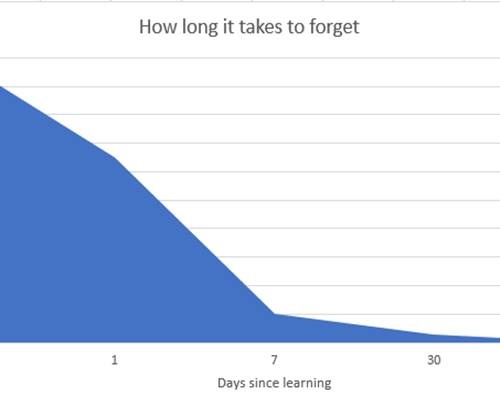
Many people would argue that there is no need to learn any information because all you need to do is Google it.
Based on this idea, all we need to teach then is how to do an internet search. I would disagree.
There are very good reasons for learning things off by heart, or rote learning, so that you have instant recall of the information.
Good reasons for rote learning
If we want to be able to do higher order tasks, for example solve a mathematical equation or read and understand a sentence, we need to have some basic information that we can call on so that we spend all our brain power on the task and almost none on the pieces that make it up.
Think about the last sentence you read.
Imagine if you had to sound out each sound in a word, then work out what the word meant, and then go on to the next one, it would take ages to get to the end of the sentence and the chances of remembering what you read at the beginning by the time you got to the end would be low.
The chances of your understanding what you read would be even lower. (As a side note, this is one of the reasons so many learners in our country have so much difficulty with reading comprehension.
They do not have the automaticity required to allow speedy completion of a sentence without extra things going on their brain –
I think of this as brain-noise – as they decode the letters and sounds and words so that they can give attention to the meaning of what they are reading.)
In the same way, not having the basic number facts automatically available means you need to focus on the minor parts of a difficult mathematical problem and so lose focus on the problem because too much brain-noise prevents focus on the higher order problem solving needed.
In these ways rote learning becomes a building block for higher order thinking.
If you are familiar with Bloom’s Taxonomy in any of its forms, you will know that remembering is the first step towards the higher cognitive processes.
Also see here: Finding our way in the world of educational technology
In these ways rote learning becomes a building block for higher order thinking.
If you are familiar with Bloom’s Taxonomy in any of its forms, you will know that remembering is the first step towards the higher cognitive processes.
Of course, this does not mean that everything should be learned by rote. As teachers we need to differentiate between needed and ‘just-in-case’ knowledge. (You can read about ‘just-in-case’ knowledge here)
How you forget
Hermann Ebbinghaus, 120 years ago, found out through experiments that there is a formula that shows how fast you forget things.
This has become know as the Forgetting Curve and has been shown to be accurate in many experiments since then.
In the graph below you can see what happens. Within one day of learning something you will only remember about 65% or so of what you learned.
Within a week you will only remember about 10% and within a month you will only remember about 2% of what you learned. I am sure you agree that is almost nothing.
(Graph by author)
The good news is that you can stop this happening and it is easy. All it takes is about 20 minutes of work over the space of a month.
Not much time at all I would say!
Remembering what you need to remember – spaced repetition
To ensure that you remember the important information you learned you need to follow these steps.
Within 24 hours of learning the new information spend 10 minutes going through your notes.
One week later spend five minutes going through the notes.
About three weeks later spend another 10 minutes going through your notes. It will probably take even less time.
Every month take a few minutes to go through the notes again and you will maintain nearly 100% of what you learned.
A slight variation to the method I would propose is that during Step 1, the first revision, a summary in the form of a mind map, flash cards where appropriate, or some other method be used to summarise the material.
This might mean that a little longer is needed for this first revision, but future revisions will be easier. I am sure you would agree it is not a big-time commitment for a huge return on the time investment.
Also read here: Preparing learners for jobs that don’t exist
Using this in our classrooms
I think it is key that our learners are taught this very important technique.
It will take them some time to get into the habit and this is where we come in as teachers.
During the lesson planning stage, you can build into your planning time for the revision at the appropriate times. This will involve a careful schedule of learning unit and when to revise.
Once the pattern is established, it will be possible to allow the learners to do the revision at home, but until then, I would suggest that you give them time in class for the revision.
You can then ensure that they are revising appropriately. If you choose to do the summary in Step 1, this is an ideal opportunity to develop this skill too with your learners.
How technology can help
More and more Learner Management Systems are incorporating spaced repetition into their functionality, and you may want to investigate this.
There are several simple apps that will make the task of revising easier.
Anki Flashcards is one app that I have found to be very useful, and it is free to use. I can also recommend Tinycards
A challenge
There is a lot of information in this article that I think is worth remembering.
I challenge you to follow these steps, and in a month’s time I am going to see how much you remember.
Find out more about Via Afrika on Facebook.
Chat back:
Share your story with Parent24. Anonymous contributions are welcome.
WhatsApp: Send messages and voicenotes to 066 010 0325
Email: Share your story with us via email at chatback @ parent24.com
Read more:
Born before technology? Or a technophobe?
A day in the life of a stay-at-home dad
This graduate believes he has the solution to youth unemployment




 Publications
Publications
 Partners
Partners

















